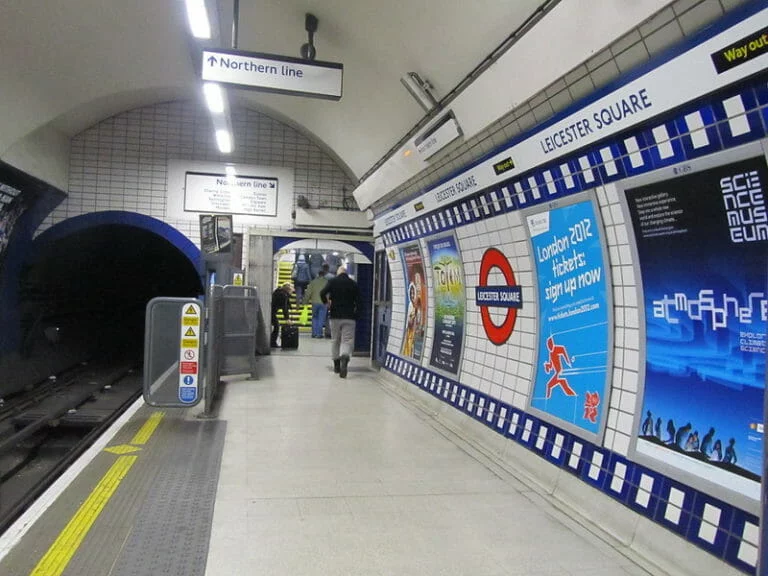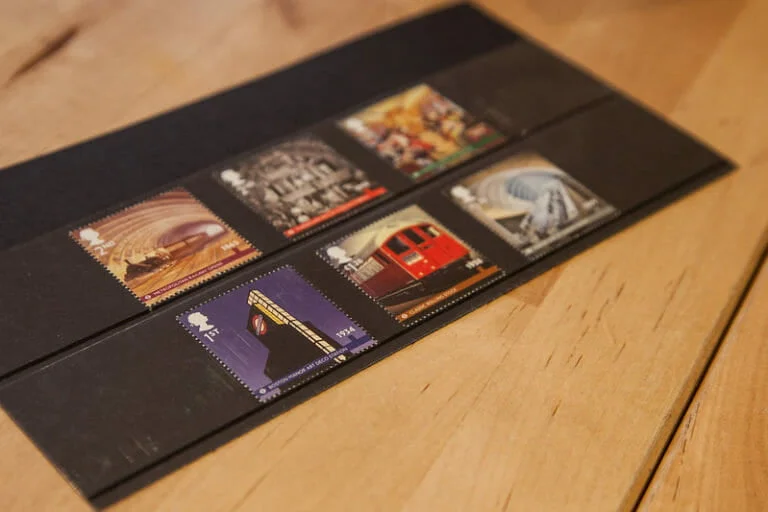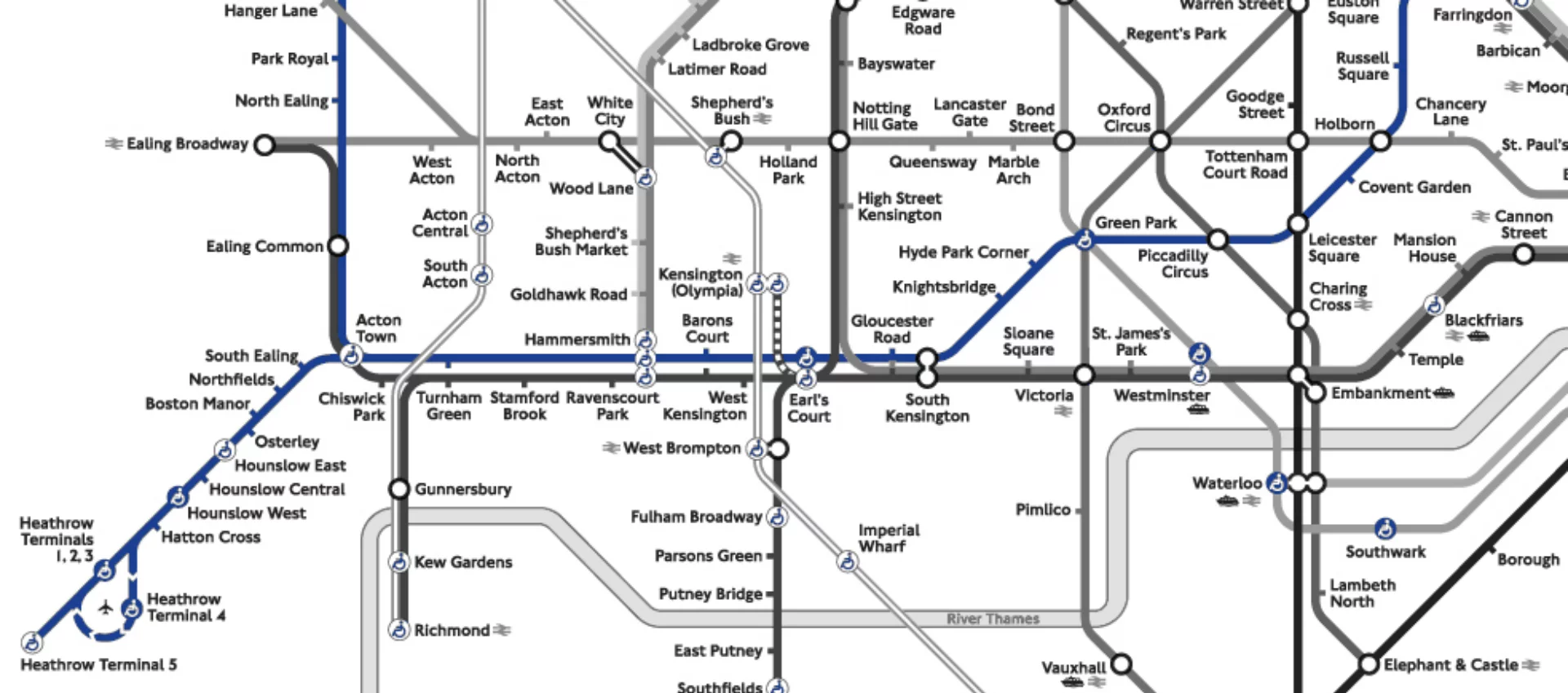You’re probably here because of our list, An Interesting Fact About Every London Tube Station.
Now, like the Underground itself, the list is pretty huge. And also like the Underground, we thought we’d make it easier to navigate – so we also created a little splinter list dedicated to stations on The Piccadilly Line (which – bonus fact! – uses Pantone 072 “Corporate Blue” as its official colour) . A list which, lo and behold, you’ll find on this very page…
Cockfosters
Being the final/first station on the line, has a tunnel designed to mirror the one at Uxbridge at the opposing end of the line.
Oakwood
The booking hall originally had a plaque claiming that the station occupied ‘the highest point in Europe in a direct line west of the Ural Mountains of Russia’, a reference to the site being 300 feet above sea level.
Southgate
When it first opened, local residents were given a free return ticket to Piccadilly Circus to encourage them to use the service.
Arnos Grove
The design of the station – which is Grade II listed – was inspired by the Stockholm Public Library.
Bounds Green
Name-dropped in the lyrics to Has it Come to This? by The Streets.
Wood Green
Gets name-dropped in songs by Razorlight (Los Angeles Waltz), Mark Knopfler (Junkie Doll), Pablo Gad (Black Before Creation), and Sway DaSafo (Up Your Speed).
Turnpike Lane
The name ‘Turnpike Lane’ refers to a toll gate erected there in 1767. And of course, the tube barriers there now technically are a toll gate, meaning the name is still accurate.
Manor House
Of its street-level entrances, three are in Hackney, and one is in Harringey.
Finsbury Park
Due to confusion with popular duelling site Finsbury Field, when it opened the station was decorated with mosaics of duelling pistols. They’re still there today.
Arsenal
The only station in the UK named after a football team.
Holloway Road
Used to have a spiral escalator (which is now stored in the Acton depot).
Caledonian Road
Named after an asylum for Scottish children built nearby in 1828.
King’s Cross St. Pancras
Has the shortest lift shaft on the network, at just 2.3 metres.
Russell Square
The sign lists the number of steps as 175. There as in fact, 171. Quite why no-one double checked is a mystery.
Holborn
Was used to store British Museum treasures during WW2. A newspaper even offered a cash reward to anyone who dared spend the night there in the ’60s amid rumours of a mummy ghost – nobody took them up on it.
Covent Garden
London Underground’s standard £4.80 single cash fare for the journey between here and Leicester Square equates to £29.81 a mile, making the fare for this particular journey more expensive per mile than the Orient Express.
Leicester Square

flierfy / Flickr
On all four platforms, film sprockets are painted down the entire length and on the top and bottom of the display area (blue on the Piccadilly line platforms, and black on the Northern line platforms), due to the four premiere cinemas in Leicester Square.
Piccadilly Circus
A world map in the station ticket hall, dating from the 1920s, contains a linear clock that shows the time in all parts of the world.
Green Park
Named after the park, which itself is said to have originally been a swampy burial ground for lepers from nearby St James’ hospital.
Hyde Park Corner
The station is located entirely underground, with no surface presence – though there is an old station building that has since been used as a pizza restaurant and a hotel.
Knightsbridge
Suffered huge congestion problems, which were solved when they built an exit specifically for Harrods.
South Kensington
Between South Kensington and Knightsbridge, the tube steers away from following the road above it in order to avoid a large plague pit.
Gloucester Road

Ian Wright / Flickr
Has a disused platform that’s used as an art exhibition. (Technically making it a used platform.)
Earl’s Court
The site of the last remaining blue police telephone box – radios took over in the 1970s.
Barons Court
Mahatma Gandhi lived at 20 Barons Court Road, a few yards from the station, while studying law.
Hammersmith
Technically, it’s two stations – one District/Piccadilly, one Hammersmith & City/Circle. And to get from one to the other without walking would require a minimum of 10 stops and 3 changes.
Turnham Green
Wheeler’s Florist, based directly outside the station, has provided flowers for Bond & Batman movies. Which, apparently, had flowers in them.
Acton Town
Alphabetically, the first tube station on the network.
South Ealing
Has all five vowels in its name.
Northfields
The 5th President of the US, John Quincey Adams lived next to the site of the station for two years.
Boston Manor

Tom Page / Flickr
Thanks to its Art Deco design, the station appeared on a postage stamp in 2013.
Osterley
This building replaced the earlier Osterley & Spring Grove station, 300 metres away, which is now Osterley Bookshop. Inside the bookshop the archway to the platforms is still visible, but blocked off, and the platforms are still in place.
Hounslow East
In the 1700s, the nearby heath was notorious for successful Highwaymen – which is a neat coincidence, because Hounslow East is a perfect anagram for ‘outlaws shone’.
Hounslow Central
Replaced Hounslow Town tube station, which was open for just three years.
Hounslow West
Due to the nearby military barracks, Winston Churchill used to frequent this station.
Hatton Cross
On its opening in 1975, Hatton Cross was one of 279 active stations on the London Underground, the highest ever total; the number of stations in the network has since decreased to 270.
Heathrow Terminal 4
It is the only station on the network to have one-way train service.
Heathrow Terminals 2 & 3
Back when it opened in 1977, it was the first time that an airport had been directly served by an underground railway system.
Heathrow Terminal 5
Despite being underground, the ceiling is made from laminate panels, allowing natural daylight to illuminate it.
Ealing Common
Has a heptagonal ticket hall, one of only two on the network.
North Ealing
Is not actually north of Ealing, but east of it.
Park Royal
The station platforms aren’t actually level – they slope up from south to north.
Alperton
Has the only remaining wooden escalators on the network, bricked up behind a wall.
Sudbury Town
Has a barometer hanging above the ticket hall from the 1930s – in fact, it’s the only station with a barometer still in it.
Sudbury Hill
The station is said to have one of the highest levels of ‘pigeon customers’ in the whole London Underground network. Staff often have to chase large numbers of the birds out of the ticket hall.
South Harrow
The train actually travels over a marsh north of the station. It crosses it via aquaeduct.
Rayners Lane
When the station first opened, there was only one single house nearby, owned by a farmer named Daniel Rayner. The station was duly called Rayner’s Lane.
Eastcote
Was originally called Ascot.
Ruislip Manor
Suffered heavy aerial bombardment by the Luftwaffe during WW2, due to its proximity to RAF Northholt.
Ruislip
Due to the convoluted tracks, it’s actually possible to reverse trains here, but it takes up both platforms, so it’s not done at peak hours.
Ickenham
Said to be haunted each Christmas since the ’50s by a woman in a red scarf, who was electrocuted there. She flails her arms, apparently.
Hillingdon
The name Hillingdon is Middle English, and means “Hill’s hill”.
Uxbridge
Being the final/first station on the line, has a tunnel designed to mirror the one at Cockfosters at the opposing end of the line.
Enjoyed that Piccadilly Line trivia? Check out the other lines right HERE.
